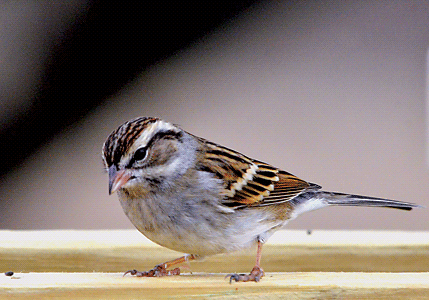SPARROWS AND A WEAVER FINCH
 Sparrows have a bad name. Many people don’t like them. Ask why and people who dislike them say they’re just little brown and gray birds. They’re colorless. They’re noisy too, but they don’t sing. They just chirp. They’re messy. They make nests that are bunches of sticks, grass and, often, pieces of paper and they frequently build their nests in the eaves, in rain gutters and behind shutters, around our houses, our garages, sheds and other buildings.
Sparrows have a bad name. Many people don’t like them. Ask why and people who dislike them say they’re just little brown and gray birds. They’re colorless. They’re noisy too, but they don’t sing. They just chirp. They’re messy. They make nests that are bunches of sticks, grass and, often, pieces of paper and they frequently build their nests in the eaves, in rain gutters and behind shutters, around our houses, our garages, sheds and other buildings.
Sparrows nest in birdhouses too, using houses put out for bluebirds, tree swallows and house wrens if the wren house entrance hole is big enough. They’re aggressive and they’re belligerent enough to drive away other birds. They’ll even kill the nestlings and destroy the eggs of earlier nesters, then move in and build their own nest.
All of those things are true – about house sparrows. But house sparrows, once named English sparrows, aren’t truly sparrows. They’re birds of a different family, birds of family called weaver finches, an Old World family.
True sparrows are natives of America, not Europe. Like the house sparrow they’re little brown and gray birds. But some of them have spots of color, white at least. The white-crowned sparrow has black and white on its head. The white-throated sparrow has a white throat and a spot of yellow on each side of its face between its eye and its bill. The chipping sparrow and the tree sparrow have caps of chestnut brown. The golden-crowned sparrow has a topknot of yellow and the vesper sparrow has white feathers on the sides of its tail.
House sparrows were introduced to America first in 1850. There were more introductions but they probably weren’t necessary. Adapted to living around people house sparrows took up life in the New World quickly, multiplied and spread until they are now one of the most common, most numerous birds of North America.
White-crowned, white-throated, chipping, tree, golden-crowned, those are just a few of the true sparrows. There’s a song sparrow, a field sparrow, a sage sparrow, a swamp sparrow and a seaside sparrow. There are Harris’s, Bachman’s, Botteri’s, Henslow’s, Harris’s, LeConte’s and Lincoln’s sparrows. There are fox and grasshopper sparrows. Each is adapted to a specific habitat, a certain niche and is limited in distribution, not, as it seems, everywhere, like the house sparrow.
I have house sparrows around my home. Doesn’t everybody? I also have song and chipping sparrows. I see house sparrows almost whenever I look out a window at one of my bird feeders during the day. But I have to go outside and look and listen to see a song or a chipping sparrow. They don’t come to my bird feeders.
Usually I hear a song sparrow or a chipper before I see it. The song, living up to its name, begins each vocalization with three or four clear whistled notes then goes into a pleasing, bubbling performance. The chipping, also living up to its name, gives a rapid series of chipping notes, a trill. Both build cup-shaped nests among the smaller branches and leaves of the trees and bushes of my yard.
I like sparrows, birds of the sparrow family. I used to say I liked American sparrows but the house sparrow is so common it has to be considered American.
All sparrows are little brown birds, little brown jobs or LBJ’s to bird watchers. As such many are difficult to identify. They’re challenging, particularly grassland sparrows. When you can identify, distinguish between Henslow’s sparrows, LeConte’s sparrows and grasshopper sparrows or song and Savannah sparrows you can consider yourself an expert birder.
All sparrows eat insects, and seeds of course, and some fruit. Birds that eat insects can’t be all bad, can they?
- Birds As Weather Forecasters – Life In The Outdoors - December 17, 2021
- Rare Bird Spotted In Indiana – Life In The Outdoors - October 8, 2021
- MY EXPERIENCE WITH DEER – Life In The Outdoors - July 30, 2021


